Appendicitis
Appendicitis is a condition in which your appendix gets inflamed. The appendix is a small pouch attached to the end of the large intestine.
Appendicitis - Animation
You may never have given much thought to your appendix, the little pouch that's attached to the top of your large intestine. And you wouldn't have much reason to think about it, because it doesn't seem to do anything. But if your appendix were to become swollen and inflamed, it would probably move to the front of your mind. The pain of appendicitis can make you quickly, and unpleasantly, familiar with this organ. You can get appendicitis if your appendix becomes blocked. That blockage could be from feces, a foreign object, or, in rare cases, a tumor. When your appendix is blocked up, bacteria that normally live inside it start multiplying like crazy, and cause an infection. If you've got appendicitis you'll usually have pain that's centered around the area of your belly button. At first the pain may be minor, but it can get very severe and will usually drift downward to the bottom right part of your abdomen. You may also have nausea, vomiting, diarrhea or constipation, and a low fever. Your pain may let up for a time. This relief can be misleading, though. Just when you think you're getting better, your appendix may have actually burst. If that's the case, the pain will get start to get more and more intense. To diagnose appendicitis, your doctor will ask about your symptoms and press on your abdomen, which will feel very tender. You may need imaging tests, such as a CT scan or ultrasound of your abdomen, so the doctor can see if the problem is with your appendix. If you have appendicitis, the number one way to treat it is with surgery to remove your appendix. In fact, appendicitis is the number one cause of emergency abdominal surgery in the U.S. You may be treated for an infection first, before your surgery. It's important to treat the appendicitis quickly because you can develop a collection of pus called an abscess in your abdomen once your appendix bursts. Don't worry about going through life without an appendix. People live healthy lives without it. Once you've had your appendix taken out, you should feel a lot better. If your appendix has ruptured, it may take you longer to recover. You may also develop an abscess or other complications. That's why you don't want to wait until your appendix has already burst to get treated. Call your doctor for any severe pain in your abdomen, especially if you also have a fever, vomiting, constipation, dizziness, or other severe symptoms.
Causes
Appendicitis is a very common reason for emergency surgery. The problem most often occurs when the appendix becomes blocked by feces, a foreign object, a tumor or a parasite in rare cases.
Tumor
A tumor is an abnormal growth of body tissue. Tumors can be cancerous (malignant) or noncancerous (benign).
Read Article Now Book Mark Article
Appendicitis
The appendix is a small finger-shaped tube that branches off the first part of the large intestine. The appendix can become inflamed or infected causing pain in the lower right part of the abdomen.
Symptoms
The symptoms of appendicitis can vary. It can be hard to detect appendicitis in young children, older people, and women of childbearing age.
The first symptom is often pain around the belly button or mid upper abdomen. Pain may be minor at first, but becomes more sharp and severe. You may also have a loss of appetite, nausea, vomiting, and a low-grade fever.
The pain tends to move into the right lower part of your belly. The pain tends to focus at a spot directly above the appendix called McBurney point. This most often occurs 12 to 24 hours after the illness starts.
McBurney point
Abdominal point tenderness is the localized pain you feel when pressure is placed over a certain part of the belly area (abdomen).

Your pain may be worse when you walk, cough, or make sudden movements. Later symptoms include:
- Chills and shaking
- Hard stools
- Diarrhea
- Fever
- Nausea and vomiting
Exams and Tests
Your health care provider may suspect appendicitis based on the symptoms you describe.
Your provider will do a physical exam.
- If you have appendicitis, your pain will increase when your lower right belly area is pressed.
- If your appendix has ruptured, touching the belly area may cause a lot of pain and lead you to tighten your muscles.
- A rectal exam may find tenderness on the right side of your rectum.
A blood test will often show a high white blood cell count. Imaging tests that may help diagnose appendicitis include:
- CT scan of the abdomen
CT scan of the abdomen
An abdominal CT scan is an imaging test that uses x-rays to create cross-sectional pictures of the belly area. CT stands for computed tomography....
 ImageRead Article Now Book Mark Article
ImageRead Article Now Book Mark Article - Ultrasound of the abdomen
Ultrasound of the abdomen
Abdominal ultrasound is a type of imaging test. It is used to look at organs in the abdomen, including the liver, gallbladder, pancreas, and kidneys...
 ImageRead Article Now Book Mark Article
ImageRead Article Now Book Mark Article
Treatment
Most of the time, a surgeon will remove your appendix as soon as you are diagnosed.
Remove your appendix
An appendectomy is surgery to remove the appendix.

Appendectomy - Animation
Appendectomy, the removal of the small pouch attached to the beginning of your large intestine when you have an acute bout of appendicitis is one of the most common emergency abdominal surgeries. The appendix is a small, finger-shaped organ that comes out of the first part of the large intestine. It needs to be removed when it becomes swollen or infected. If the appendix is not removed, it can leak bacteria and infect your entire belly, which can be very life threatening. So, what are the signs that you have appendicitis? Well, this condition can be fairly hard to diagnose, especially in children, older people, and women of childbearing age. Usually, the first symptom is pain around your belly button. The pain might be mild at first, but then it gets sharp and severe before not too long. The pain may then move into your right lower abdomen. You may also have diarrhea, fever, nausea, and a reduced appetite. Sometimes, people think that they might be having food poisoning. Your doctor will make a diagnosis based on your symptoms. You may also have blood tests and a CT scan or ultrasound. Once it's clear that you have appendicitis, your doctor will probably schedule you for emergency surgery. In surgery, you will receive anesthesia and be asleep and pain free. The doctor will make a small cut in the lower right side of your belly and remove your appendix. If the surgeon uses the laparoscopic technique, you will have several small cuts in your abdomen for the surgical instruments. If your appendix broke open, or a pocket of infection has formed, your doctor will wash out your belly during the surgery. A small tube may remain to help drain out fluids or pus. Once you've had an appendectomy, you will probably recover pretty quickly. It feels good to get a bad appendix out. Most patients leave the hospital 1 to 2 days after surgery. The good news is that you'll be able to go back to all those normal activities within 2 to 4 weeks.
If a CT scan shows that you have an abscess, you may be treated with antibiotics first. You will have your appendix removed after the infection and swelling have gone away.
Abscess
An abscess is a collection of pus in any part of the body. In most cases, the area around an abscess is swollen and inflamed.

The tests used to diagnose appendicitis are not perfect. As a result, the operation may show that your appendix is normal. In that case, the surgeon will remove your appendix and explore the rest of your abdomen for other causes of your pain.
Outlook (Prognosis)
Most people recover quickly after surgery if the appendix is removed before it ruptures.
If your appendix ruptures before surgery, recovery may take longer. You are also more likely to develop problems, such as:
- An abscess
- Blockage of the intestine
- Infection inside the abdomen (peritonitis)
- Infection of the wound after surgery
When to Contact a Medical Professional
Contact your provider if you have pain in the lower-right portion of your belly, or other symptoms of appendicitis.
Pain
Abdominal pain is pain that you feel anywhere between your chest and groin. This is often referred to as the stomach region or belly.

Reviewed By
Michael M. Phillips, MD, Emeritus Professor of Medicine, The George Washington University School of Medicine, Washington, DC. Also reviewed by David C. Dugdale, MD, Medical Director, Brenda Conaway, Editorial Director, and the A.D.A.M. Editorial team.
Carlberg DJ, Himelfarb NT. Acute appendicitis. In: Walls RM, ed. Rosen's Emergency Medicine: Concepts and Clinical Practice. 10th ed. Philadelphia, PA: Elsevier; 2023:chap 79.
Garcia EM, Camacho MA, Karolyi DR, et al. ACR appropriateness criteria right lower quadrant pain -- suspected appendicitis. J Am Coll Radiol. 2018;15(11S):S373-S387. PMID: 30392606 pubmed.ncbi.nlm.nih.gov/30392606/.
Rosenthal MD, Sarosi GA. Appendicitis. In: Feldman M, Friedman LS, Brandt LJ, eds. Sleisenger and Fordtran's Gastrointestinal and Liver Disease: Pathophysiology/Diagnosis/Management. 11th ed. Philadelphia, PA: Elsevier; 2021:chap 120.
Sifri CD, Madoff LC. Appendicitis. In: Bennett JE, Dolin R, Blaser MJ, eds. Mandell, Douglas, and Bennett's Principles and Practice of Infectious Diseases. 9th ed. Philadelphia, PA: Elsevier; 2020:chap 78.


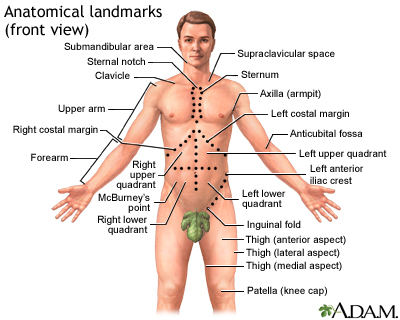



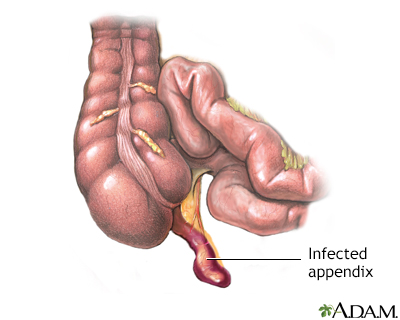
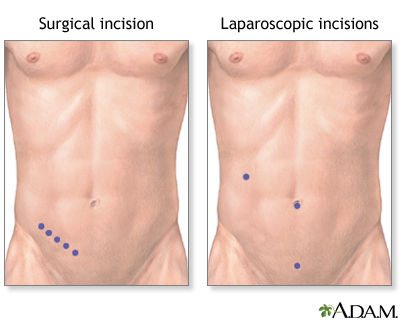
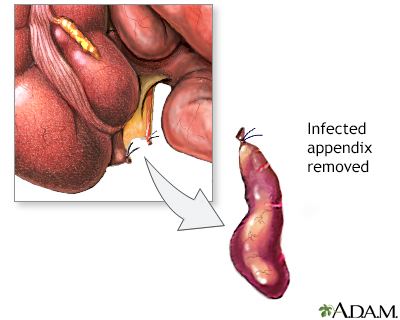
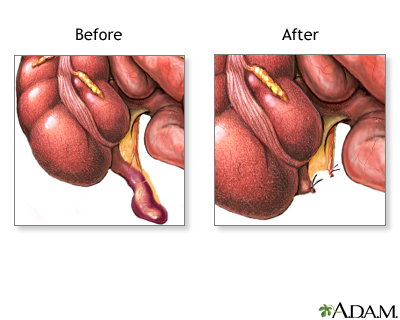
 All rights reserved.
All rights reserved.